ISSN ONLINE(2319-8753)PRINT(2347-6710)
ISSN ONLINE(2319-8753)PRINT(2347-6710)
Pravinraj.EL1, Manjinder Bajwa2 and Mahipal Singh2
|
| Related article at Pubmed, Scholar Google |
Visit for more related articles at International Journal of Innovative Research in Science, Engineering and Technology
The spheroidal graphite iron (ductile iron) is known for its good elongation (ductility) property at casting process at the part of low tensile strength. If the SGI is to produce good tensile strength, the elongation is gradually decreases. So an experimental research was conducted by chemical composition (high percentage of Cu) to improve the tensile strength, hardness as well as elongation together with the variation of austempering temperature and different time period. The variables, austempering temperature were varied from 2500 C to 3000 C and for holding time period of 10, 20 and 30 minutes. The results of experiments showed that with an increase of austempering temperature and time, the tensile strength and hardness decreases whereas the elongation increases.
Keywords |
| Ductile Iron, Copper, Austempering Temperature, Time, Tensile Strength, Hardness, Elongation. |
INTRODUCTION |
| CAST IRON: The term of cast iron refers to family of ferrous alloy composed of iron, carbon and silicon (up to 3.5%). Cast iron is usually classified according to their solidification morphology and by their structure (ferrite, pearlite, quenched and tempered or austempered). Cast iron have lower melting temperature then steels, which is why casting process is so suitable for iron with high carbon content. Cast iron represents the largest amount of all metals cast, and they can easily be cast in to complex shapes. They generally posses several desirable properties, such as strength, wear resistance, hardness, and good machinability (1). |
| DUCTILE IRON: Ductile cast iron is a relatively new ferrous alloy because of a wide range of properties. It can be stronger than mild steel, yet poured from a low cast melting furnace. It is called spheroidal cast iron or nodular cast iron because the free graphite this metal is in the form of tiny balls (spheroids or nodules) rather than the flakes as present in grey cast iron. The structure of spheroidal graphite formation is given in figure 2. |
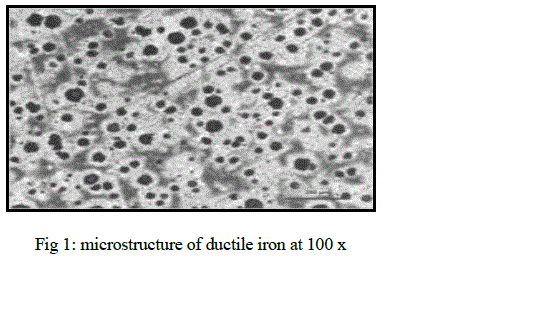 |
| Ductile iron is obtained by controlling chemical composition of the metal and also by adding magnesium (in the form of magnesium-Ferro-silicon) in the molten metal. The add element alters the surface tension of the graphite in the molten iron causes it to condense into spheroids. In the form of tiny balls, graphite has no detrimental effect upon the mechanical properties of matrix. One reason for the phenomenal growth in the use of ductile iron casting is high ratio of performance to cost that they offer the designer and end user. This value results from many factors, one of which is control of microstructure and properties (2). |
| DIFFERENT GRADES OF DUCTILE IRON: Tensile properties are given in Table.1 relation to standard specifications (ISO 1083:1987), which refer only to the minimum values of strength and ductility and mean hardness ranges to be expected. Higher strengths and greater elongations will generally be expected in commercial castings of good graphite structure. |
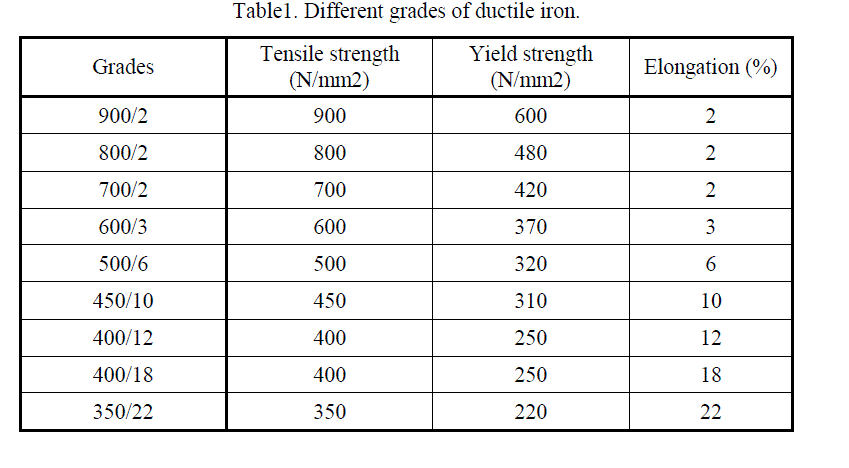 |
| COMPOSITION OF DUCTILE IRON: The chemical composition play key role of mechanical and physical properties of ductile iron. The mechanical properties change in to the corresponding composition. |
| 1.Silicon: Addition of Silicon results in the presence of both ferrite and pearlite in the matrix. Silicon enhances the performance of ductile iron at elevated temperature by stabilizing the ferrite matrix and forming a silicon reach surface layer, which inhibits oxidation. |
| 2. Manganese: |
| 1. Mn is a pearlite promoter. |
| 2. Improves yield strength and hardness to a small extent. |
| 3. Copper: |
| 1. Cu is a strong pearlite promoter. |
| 2. It increases the yield strength as well as the tensile strength and hardness. |
| 3. So in the pearlite grade of the ductile iron, 0.4-0.8% of Cu is added. |
4. Nickel: |
| 1. Ni helps in increasing the U.T.S without affecting the impact values. |
| 2. It strengthens ferrite, and reduces ductility, but to a much lesser extent than that of silicon. |
5. Molybdenum: |
| 1. Mo is a mild pearlite promoter. |
| 2. Mo increases yield strength and hardness. |
| 3. Mo also improves elevated temperature properties. |
6. Chromium: |
| 1. Cr prevents corrosion by forming a thin layer of chromium oxide over the surface and stops further exposition of the surface to the atmosphere. |
| 2. But as it is a strong carbide former, hence it is not desirable in carbide free structures. |
7. Magnesium: |
| 1. Magnesium works as the modifier in the matrix and nodularizes the graphite so as to increases the ductility and yield strength. |
8. Sulphur and Phosphorus: |
| 2. Phosphorous is intentionally kept very low because its presence causes cold shortness and the property of ductile iron gets impaired. |
| 3. Addition of Sulphur is done for better machinability but is kept low, a maximum of 0.015%, as larger sulphur addition may cause the hot (red) shortness (3). |
| AUSTEMPERING: It is a kind of tempering process which consist of holding the iron in a molten salt bath having temperature of 250o to 500o C above the critical temperature when the structure consists purely of austenite. The part is held at the quenching temperature for a time sufficient to give complete transformation to an intermediate structure referred as bainite. It is then cooled to room temperature. It works best on work pieces of small and delicate crosssection and appears to be most beneficiate in steel with carbon content ranging from 0.5 to 1% (4). |
LITERATURE REVIEW |
| J.sikora and R.Boeridone, researched together the metallurgical influence of the final microstructure and mechanical properties of ductile iron. It was concluded that solidification of austenite has heavy large grain size while recrystallized austenite, obtained through austenitization has much small grain size. This grain size affects distribution of microstructure and mechanical properties of SGI. Effects of ratio of C/Si, pig iron, nodularizer and alloying method on the microstructure and mechanical properties of SGI (ductile iron) and also produce the high quality nodular casting even if much anti spoheroidizng alloy are included in the pig iron by adding the RE-Mg plus Sb. Also, it stated the result that ductile iron had good nodularity and ferrite and pearlite matrix by using high-quality pig iron Fe-Si-Mg+Ni- Mg nodulizer, but mechanical properties are low (5). |
| E.Guzik et al. in their research used the high Mg ferrosilicon alloy in core wired for the production of vermicular graphite iron at the injected methods for the pearlite and ferrite matrix with about 25% ferrite content. It was founded that Mg master alloy and the cored wire treatment for the vermicular cast iron with proper content of Cr, Cu, Mn, as well as Mg enable to obtain material with good UTS, Yield strength and hardness as of a cast iron of 400/18 grade (6). |
| M.A.Yescas et al. Concluded that in austempered ductile cast irons as a function of their chemical composition (C, Mn, Si, Ni, Mo, Cu), and the austenitisation and austempering parameters. The model successfully reproduces many experimentally observed trends. It can be exploited in two ways, first in the design of cast irons and their heat treatments, but also to identify whether experiments are needed in the future (7). |
| Ravishankar K.S et al. studied the development of austempered ductile iron for high tensile strength and the found, two step austempering results in microstructure consisting of a mixture of upper and lower bainite, the relative proportion of which depends on the first step time. Tensile strength and yield strength increase with increasing first step time, while the ductility and tensile toughness decrease. The improved fracture toughness obtained through two step austempering can be attributed to fine ferrite particle size, increase carbon content of retained austenite, and the increase stability of retained austenite. A combination of high fracture toughness and high tensile toughness can be achieved by adopting two step austempering processes (8). |
EXPERMENTAL WORK |
| In this research work the analysis of mechanical properties (tensile, elongation and hardness) of ADI was done with an alloy composition. The composition of alloy addition in sample is given below table 2. |
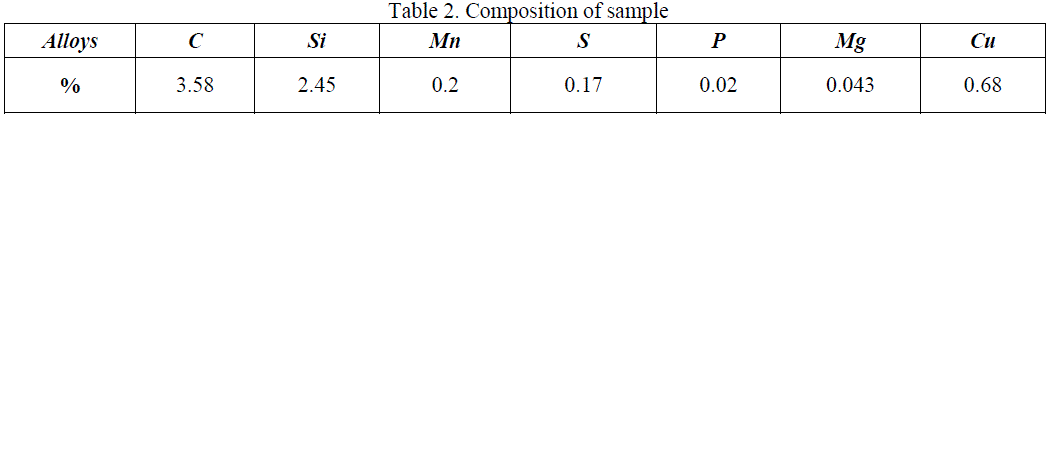 |
| The content of alloy elements was controlled so that there would be certain amount of ferrite and pearlite in the matrix of the ductile iron. With this composition, all specimens were austenite at two different temperatures of 9000C and 950oC for 2 hrs. Then these samples were kept in muffle furnace to reduce the temperature up to 6000C. Once the temperature reaches 600oC, the samples were transferred to the salt bath (combination of salt water is 50% NaNO3 and KNO3) at two different 2500, 3000C temperature for 10, 20 min respectively as described in the working sheet given in table 2. The Salt water temperature had been monitored by digital temperature meter. After that the samples were allowed to cool in still air up to the room temperature. The graph of the process is shown in figure2. |
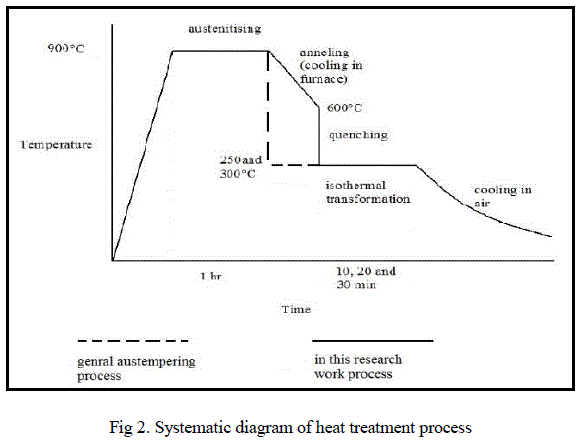 |
| After heat treatment process the test sample are carefully tested in mechanical testing laboratory. The testing procedures briefly explained in following topics |
| TENSILE TEST: Using a vernier calliper the thickness and the total length of the specimen was measured. The diameter of the specimen and the gauge length which was fixed at 50mm was fed to the testing machine. The distance between the jaws was fixed according to the gauge length of the specimen. The specimen was gripped by the jaws and axial load was applied to it. |
| ELONGATION: The failed parts of the specimen are taken and joined together and the length of the specimen was measured. The elongation of the specimen was measured and the % elongation calculated. Formula of elongation is given below, |
 |
| HARDNESS TEST: The hardness of the specimen as received as well as that of the entire ADI specimen was measured using Rockwell Hardness tester. Hardness was measured in Rockwell B scale. The Rockwell B scale utilizes a ball indenter and a major load of 50 kg. The hardness testing specimen measuring face was polished with a grinding machine. The specimen was seated on the specimen holder. The measuring face of the specimen which remains in contact with the specimen holder should be parallel to the surface of the holder. Also the face on which indentation is to be made should be plane. Now, a holder lift to the ball indenter until the reading on the display is zero. After that, load of 50 kg is applied on the specimen by lever. After given load should be wait for 30 sec. After 30 sec the lever was released and noted the hardness value. For every specimen, hardness value was found out on three different places and the average value was taken as the hardness of the specimen |
RESULT AND DISCUSSION |
| The results of the experiment performed in the laboratory are given below in the table 3 which helps to describe the effect of different austempering temperature and time on the mechanical properties of SGI. |
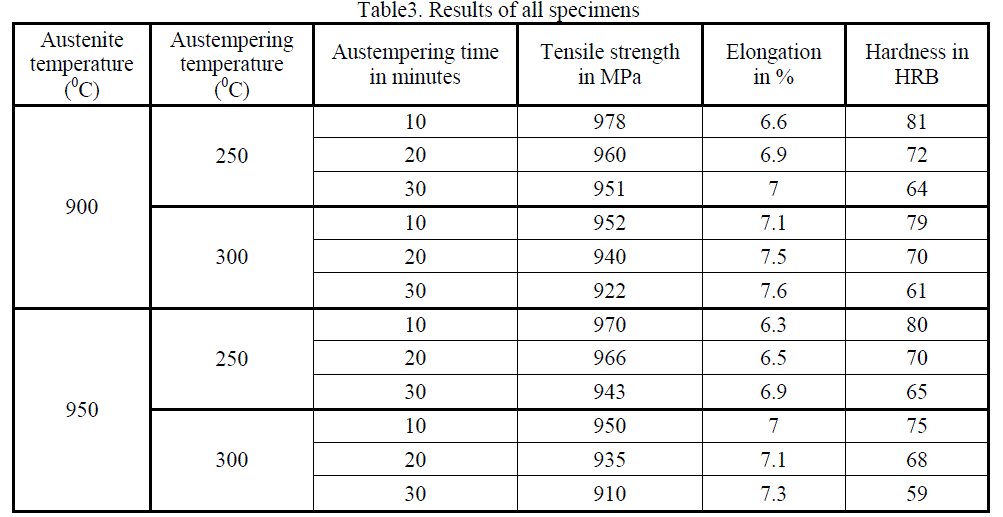 |
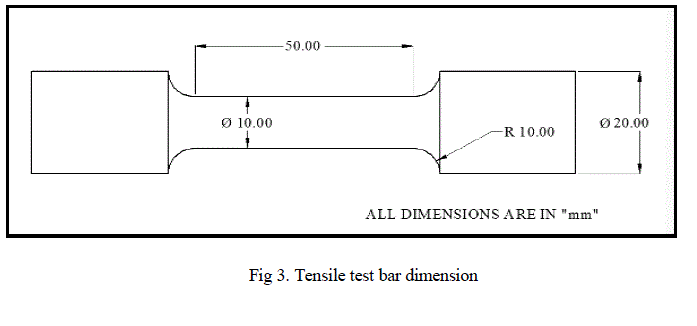 |
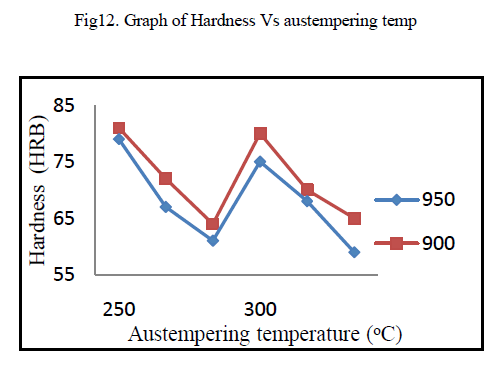 |
| The graph of figure 10, 11 and 12 describes about changes in the tensile, elongation and hardness with respect to different austenite temperature 9000 and 9500C with different austempering temperature. It is seen that the tensile and hardness gradually decreases when austempering temperature increases. At lower austempering temperature, the high strength and high hardness value attributed to the presence of acicular bainite, some martensite and retained austenite. The fine structure of the bainite plates and low amount of retained austenite results in high strength and hardness at low austempering temperature. Mean while the higher austenite temperature having sow tensile and hardness strength because the annealing temperature reduces (9500-6000C) take more time than lower austenite temperature. The low ductility of austempered ductile iron at low austempering temperature can be attributed to the brittle fracture occurring due to the presence of martensite in the microstructure. Also the amount of retained austenite at low temperature is less resulting in less amount of elongation. |
CONCLUSION |
| From this research work it is concluded that when the austempering temperature decreases, the tensile strength and hardness gradually increases. On the other hand, when the austempering time and temperature increases, the elongation also increases. |
FUTURE WORK |
| Further research can be done with different chemical composition and with different percentage of Mn and Cu. Also with the different austempering temperature (i.e., 3500C and 4000C) and with different time period (i.e., 45 min, 60 min and 90 min) along with different annealing temperature. |
References |
|